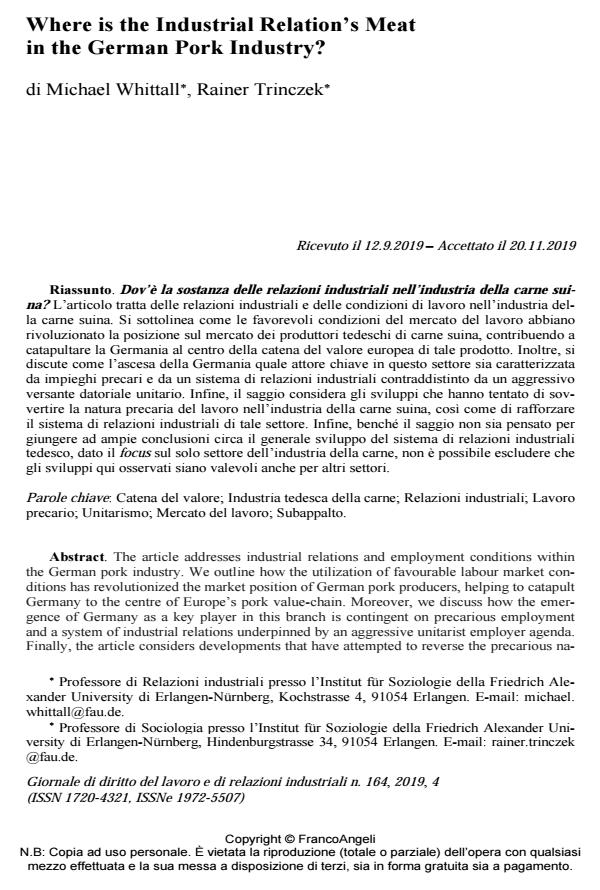Where is the Industrial Relation’s Meat in the German Pork Industry?
Titolo Rivista GIORNALE DI DIRITTO DEL LAVORO E DI RELAZIONI INDUSTRIALI
Autori/Curatori Michael Whittall , Rainer Trinczek
Anno di pubblicazione 2020 Fascicolo 2019/164
Lingua Inglese Numero pagine 18 P. 695-712 Dimensione file 276 KB
DOI 10.3280/GDL2019-164005
Il DOI è il codice a barre della proprietà intellettuale: per saperne di più
clicca qui
Qui sotto puoi vedere in anteprima la prima pagina di questo articolo.
Se questo articolo ti interessa, lo puoi acquistare (e scaricare in formato pdf) seguendo le facili indicazioni per acquistare il download credit. Acquista Download Credits per scaricare questo Articolo in formato PDF

FrancoAngeli è membro della Publishers International Linking Association, Inc (PILA)associazione indipendente e non profit per facilitare (attraverso i servizi tecnologici implementati da CrossRef.org) l’accesso degli studiosi ai contenuti digitali nelle pubblicazioni professionali e scientifiche
The article addresses industrial relations and employment conditions within the German pork industry. We outline how the utilization of favourable labour market conditions has revolution-ized the market position of German pork producers, helping to catapult Germany to the centre of Europe’s pork value-chain. Moreover, we discuss how the emergence of Germany as a key player in this branch is contingent on precarious employment and a system of industrial rela-tions underpinned by an aggressive unitarist employer agenda. Finally, the article considers developments that have attempted to reverse the precarious nature of employment in the meat industry as well as strengthen industrial relations procedures. Finally, although the article is not designed to make sweeping statements about wider developments within the German in-dustrial relations system, being the focus on one particular sector, the meat industry, we cannot exclude that developments presented here could serve as a warning to other sectors.
L’articolo tratta delle relazioni industriali e delle condizioni di lavoro nell’industria della carne suina. Si sottolinea come le favorevoli condizioni del mercato del lavoro abbiano rivoluzionato la posizione sul mercato dei produttori tedeschi di carne suina, contribuendo a catapultare la Germania al centro della catena del valore europea di tale prodotto. Inoltre, si discute come l’ascesa della Germania quale attore chiave in questo settore sia caratterizzata da impieghi pre-cari e da un sistema di relazioni industriali contraddistinto da un aggressivo versante datoriale unitario. Infine, il saggio considera gli sviluppi che hanno tentato di sovvertire la natura preca-ria del lavoro nell’industria della carne suina, così come di rafforzare il sistema di relazioni in-dustriali di tale settore. Infine, benché il saggio non sia pensato per giungere ad ampie conclu-sioni circa il generale sviluppo del sistema di relazioni industriali tedesco, dato il focus sul solo settore dell’industria della carne, non è possibile escludere che gli sviluppi qui osservati siano valevoli anche per altri settori.
Parole chiave:Catena del valore; Industria tedesca della carne; Relazioni industriali; Lavoro precario; Unitarismo; Mercato del lavoro; Subappalto.
- Im Osten was Neues? Ingrid Artus, Andreas Fischer, Judith Holland, Michael Whittall, in PROKLA. Zeitschrift für kritische Sozialwissenschaft /2023 pp.245
DOI: 10.32387/prokla.v53i211.2046 - Tendenze delle relazioni industriali nel settore suinicolo: il caso italiano in un quadro europeo Giulio Centamore, Davide Dazzi, in GIORNALE DI DIRITTO DEL LAVORO E DI RELAZIONI INDUSTRIALI 165/2020 pp.57
DOI: 10.3280/GDL2020-165003 - Allemagne. Les stratégies d’IG Metall en matière de négociation collective : à l’est, rien de nouveau ? Michael Whittall, Ingrid Artus, Andreas Fischer, Judith Holland, in Chronique Internationale de l'IRES /2023 pp.67
DOI: 10.3917/chii.183.0067
Michael Whittall , Rainer Trinczek, Where is the Industrial Relation’s Meat in the German Pork Industry? in "GIORNALE DI DIRITTO DEL LAVORO E DI RELAZIONI INDUSTRIALI " 164/2019, pp 695-712, DOI: 10.3280/GDL2019-164005